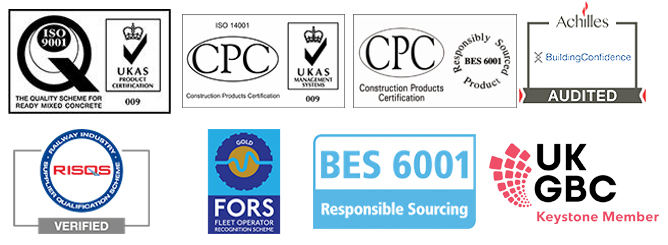Cement Bound Sand
Heidelberg Materials’ cement bound sand (CBS), Powersand, is specifically designed to protect energy infrastructure and storage. These products aim to reduce energy loss in the network, lower cable requirements, and cut costs and manpower during installation.
Our Power range includes concrete, sands, and grouts tailored to meet the needs of the energy and storage industry. With a 14:1 sand-to-cement ratio, our cement bound sand effectively conducts heat away from low- and high-voltage cables, ensuring safe, efficient electricity transmission while minimising energy loss.
| Product name | Description | Benefits |
| PowerSand CBS | PowerSand is a specialised backfill material for power cable installations. The certifies cable sand, which is ENA TS 97-1 compliant, is suitable for installation and backfilling of underground high voltage cables. | • Primarily used in rail, energy, and utilities projects, meeting all thermal property specifications • Easily compacts around power cables to effectively conduct heat away from the source and prevent electrical resistance |
| PowerSand CBS Extra | Heidelberg Materials PowerSand CBS Extra is a non-traditional stabilised backfill as defined in ENA TS 97-1, with optimised performance. | • Lower thermal resistivity to traditional CBS • Reduced carbon footprint |
| Powercrete® | Powercrete® is a robust, higher performing option compared to PowerSand. It is a heat-conducting concrete, used as a bedding and infill material for underground HV and UHV cabling. The special material properties of Powercrete® result in low heat transmission resistance. | • Improved heat dissipation for HV and UHV cables • High heat conduction after drying • Reduction in magnetic field strength for alternating current • Increased power capacity • Reduction of conductor cross-section • Switch to aluminum conductors possible • Mitigation of “hot-spots” • Powercrete® has a thermal resistivity measured at 0.4Km/W |
All our CBS products comply with Energy Network Association Technical Specification (ENA TS) 97-1 and National Grid Technical Specification (NGTS) 3.05.07, with certification available upon request.
Explore the full range of energy sector solutions from Heidelberg Materials. For more information on our Powersand cement bound sand or Powercrete ready-mixed concrete range, contact us today or request a quote.
Why Choose Our Cement-Bound Sand?
High-Quality Materials
Reliable cement bound sand for the energy sector and cabling applications.
Dedicated Account Support
Integrated account management for simplified ordering and delivery.
National Delivery Fleet
1,200 vehicles, 4 locomotives, 140 rail freight wagons.
What are the Applications of Cement Bound Sand?
We provide cement bound sand to support the following construction applications:
- Cable bedding - Cement bound sand is crucial for Energy Networks Association (ENATS) compliant projects.
- Trench stabilisation projects - CBS is used to protect and manage heat in utility trenches, such as high-voltage cabling.
Why Trust Heidelberg Materials?
Heidelberg Materials has been supplying heavy building materials, including CBS, to construction projects for over 150 years.
We offer a national network of road, ferry, and rail freight and a dedicated accounts team that has worked across all project sizes. This means you benefit from fast and reliable delivery of quality materials on time wherever they’re needed.
With 2030 sustainability goals and a commitment to net zero by 2050, we are your partner in eco-friendly construction. We adhere to ISO 9001, 14001, and 45001, ensuring you receive sustainable, high-quality cement bound sand.
Contact our team today and let us find a solution to your project requirements.
Where Do You Deliver Cement-Bound Sand?
We can deliver Powersand cement-bound sand up to a 50-mile radius from any of our 178 static and mobile production plants across the UK.
Our Accreditations
Heidelberg Materials fully conforms with ENA Technical Specification 97-1 and all our products carry this certification.

Cement Bound Sand FAQs
Learn more about cement bound sand and its uses below? For more information on our ready-mixed concrete range, visit our dedicated FAQs page.
- What is Cement Bound Sand?
-
Cement bound sand (CBS) is a weak mix of granular material (sand) and cement , designed for underground cable laying. This backfill protects cables from impacts and conducts heat from high and low-voltage cables, thereby ensuring they efficiently and safely transfer electricity.
- What Considerations Apply to Cement-Bound Sand?
-
The CBS must be exactly formulated to match the workability requirements of your project.
Proper compaction is essential for optimal thermal conductivity and to prevent cable damage.
Once laid, you should cover the site and allow enough time for it to set without shifting due to excess moisture or cracking due to excess heat.
- To What Specification is Cement Bound Sand Produced?
-
We produce CBS in line with ENA TS 97-1 and NGTS 3.05.07, with the following specification requirements:
- Grading = >95% passing a 5.0mm BS Sieve
- Mixture = 14:1 Sand to Cement Mix
- Dry Relative Density = >1.6Mg/m³
- Thermal Resistivity = <1.2°C m/W
- Void Ratio = <0.54
- Cohesion = Appendix C
- Is Heidelberg Materials’ CBS Available Nationally?
-
Yes, Heidelberg Materials offers national coverage, and our CBS complies with the requirements of ENA TS 97-1 and NGTS 3.05.07, so you can be assured of its quality. Please contact our technical sales team for more information.
- Will any 14:1 Sand Cement Mix be Suitable?
-
No, as not all materials have the required thermal conductivity. Please ensure that any material used has current UKAS-accredited test results, which take approximately four weeks to carry out, to provide assurance that the material is fit for purpose.
- How Soon Should CBS be Installed After Delivery?
-
CBS has a low moisture content, but its performance is significantly reduced if it is allowed to dry out. We recommend that it be placed and compacted within 2 hours of delivery, although this could be extended provided the material is covered in polythene sheeting to prevent moisture loss.
